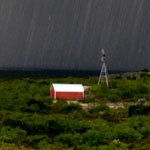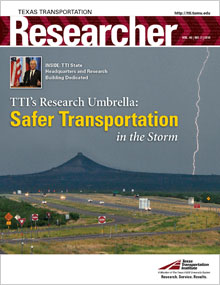
There’s an old joke in Texas: if you don’t like the weather here, wait five minutes.
Texas weather varies greatly across the 268,820 square miles of the state. We have five distinct regions, conveniently named North, South, East, West and Central Texas, and each one is known for a unique weather aspect — frozen roads in the north, sweltering heat in the west, hurricanes in the south, tornadoes in the east and pounding thunderstorms in Central Texas. Variety seems to be the only consistent thing about Texas weather.
That variety challenges the ability of agencies to operate and maintain all types of transportation systems. Research plays a key role in helping address these challenges. No matter how strong the highway, Mother Nature is always stronger. Time is on her side. Eventually the sun will bake that asphalt until it cracks. Water creeps in during winter and freezes, further splitting the roadway until it crumbles entirely, threatening motorist safety.
When it comes to safety, signage is just as important. On a clear night with a full moon, it’s easy enough to see signs warning you to slow down before that sharp curve ahead. During a thunderstorm, it becomes much harder to see those signs. And, like the roadway, time and the sun also wear down signs so they no longer reflect headlights properly.
Researchers at the Texas Transportation Institute (TTI) study the interaction of weather and our transportation system. In this issue, you’ll learn some of the ways TTI research is helping to extend road life and protect motorists.
 For example, our researchers are finding solutions to common problems, like asphalt cracking and “bleeding” (when excess asphalt binder is pushed to the pavement surface, covering the aggregate). Predicting how raised pavement markers and other retroreflective signs operate under real-world conditions is key to maximizing both the life of the sign or marker and optimizing safety for motorists. TTI‘s new State Headquarters and Research Building houses a state-of-the-art Visibility Research Laboratory, where the effects of weather on signs and markers can be tested for sponsors nationwide.
For example, our researchers are finding solutions to common problems, like asphalt cracking and “bleeding” (when excess asphalt binder is pushed to the pavement surface, covering the aggregate). Predicting how raised pavement markers and other retroreflective signs operate under real-world conditions is key to maximizing both the life of the sign or marker and optimizing safety for motorists. TTI‘s new State Headquarters and Research Building houses a state-of-the-art Visibility Research Laboratory, where the effects of weather on signs and markers can be tested for sponsors nationwide.
Thanks to the TTI-developed software MEANDER, transportation agencies can now predict the future location of rivers as rain, erosion and time alter their courses. Knowing these changes helps agencies better plan for maintenance needs on nearby structures. And with its innovative research into the use of Bluetooth® technology to track traffic flow, the Institute will help save lives by assisting regulatory agencies in choosing the best evacuation routes during a hurricane.
Everything’s bigger in Texas — even our tall tales. So maybe the weather doesn’t really change every five minutes, but if you live here, it certainly seems that way. Expecting the weather to change that quickly motivates TTI researchers to come up with solutions that are just as flexible.
So, as you read this issue, how’s the weather where you are? Is it posing a challenge to keeping the transportation system mobile and safe? Give us a call — maybe TTI can help. All we need is five minutes of your time.
